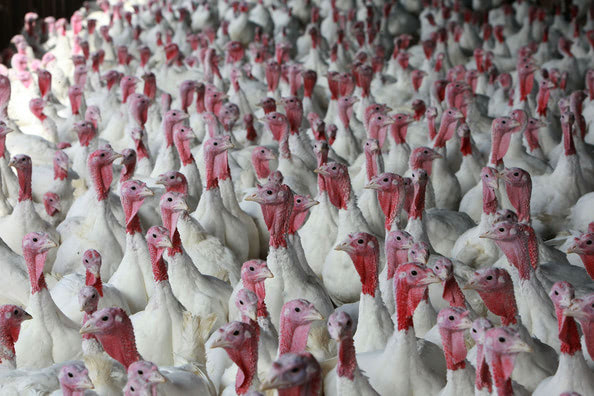Thanksgiving is fake-for-real. While it's true that there was a minor harvest feast in 1621, held by English immigrants and Wampanoag Indians, the event was never celebrated regularly, and largely dropped off the national radar for the next 200 years. It took the Civil War for Abraham Lincoln to formalize the holiday, a political move he hoped would promote national unity.
Even if the holiday is invented, at least the food is real, right? When Americans sit down to groaning tables on Thursday, it's tempting to think we're participating in a culinary tradition not that far removed from the time of the Pilgrims. Thanksgiving food is, after all, as authentic and naturally American as apples (Kazakhstan), potatoes (Peru), and green bean casserole (Campbell Soup Company). Maybe we can find some culinary authenticity hiding between the gravy boat and the cranberry sauce. Hope you're hungry...
No Potatoes, No Pigs, No Fun
Most so-called "traditional" Thanksgiving dishes would have been alien to the Indians and Pilgrims in attendance at Plymouth, Massachusetts. They might not even have recognized mashed potatoes, sweet potatoes or cranberry sauce as edible food. Sweet corn, the kind that can be eaten fresh from the cob, may not even have existed at the time, let alone been grown in Massachusetts. Apples, so vital for pie, were also off the menu. The English settlers had to wait for their imported apple seeds to grow, and on top of that, their crops were measly until they carted European honey bees across the ocean to fertilize the orchards. Forget ham, pork, or sausage too; the settlers were not the pig-raising types. And as for drinks? Nothing but water.
Plenty of Eel to Go Around
Most Americans nowadays would be just as puzzled by historical Thanksgiving foods. Pumpkin and other squash were likely eaten on the menu, but only as part of savory dishes. Other foods that Wampanoag and English gobbled down have been completely relegated to history. Venison is one of the few certainties of the first Thanksgiving – the Wampanoag brought a gift of five deer for the meal – but venison, like all wild game, is a rare sight nowadays. Clams, mussels, oysters, eels, cod, and lobster were also in abundance in Plymouth, not to mention turtle. Seafood, so vital in 1621, would look as out-of-place in a modern Thanksgiving spread as a mapo tofu.
At Least They Ate Turkey?
Turkey is a likely candidate for the Thanksgiving food that's managed to survive the centuries unscathed – maybe. Wild turkeys were abundant in 1621, and Indians and immigrants alike enjoyed the bird. That's not to say that M. gallopavo was actually served at the feast. The Pilgrims would have been just as likely to eat wild ducks, or even swans. Cookbooks from early American history preserve an astonishing appetite for wood cock, partridge, snipe, pigeons, and song birds of all kinds. Literally anything with meat on its bones and feathers on its back was chucked into the stew pot. For a real authentic feel for your Thanksgiving dinner, you might want to set up a bird feeder and shoot the first thing that lands.
Gobble, Gobble, Wobble
But let's not be so fast about the turkey. Is our own iteration of the bird really that authentic to the holiday? Snow-white, broad-breasted, and enormous, the modern turkey would have perplexed the Pilgrims. 99.99% of all turkeys sold in the United States come from a single breed of turkey, the aptly-named Broad Breasted White. The most popular breed of turkey for over three centuries was the Bronze, a cross between wild turkeys and European domestics. During standardization and science obsessed 1960s, Bronzes and other old breeds like Bourbon Red or Slate Black Spanish all but disappeared from American farms.
Bizarre and marvelous, Broad Breasted Whites lost their natural bronze coloration because white pin feathers make the plucked carcasses more attractive to consumers. They reach market weight up to 12 weeks before 'heritage' breeds, and weigh in at around 18 kilos per bird, compared to a measly 10 kilos for a wild turkey. True freaks of this breed can grow as large as 36 kilos. Great for producing breast meat, the Broad Breasted White is not that great at being it bird. They can't fly, their legs get bowed and wobbly under their weight, and their giant breasts prevent them from reproducing as nature intended – thanks, artificial insemination!
A Faux Feast
There aren't many "100% natural" foods, and there is no one "authentic" Thanksgiving. Culture largely decides what we accept as historical reality. In a hundred or two hundred years, future Americans may be astonished to learn to that the Wampanoag did not come bearing gifts of dinosaur meat, and the Pilgrims did not chow down on the most American vegetable of all, pizza.
Image via Zimbio.

Share your thoughts and join the technology debate!
Be the first to comment